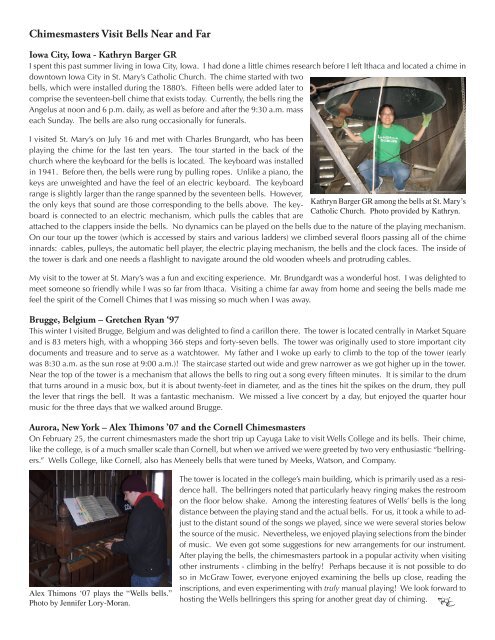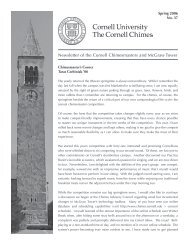No. 38 â Spring 2007 - The Cornell Chimes - Cornell University
No. 38 â Spring 2007 - The Cornell Chimes - Cornell University
No. 38 â Spring 2007 - The Cornell Chimes - Cornell University
You also want an ePaper? Increase the reach of your titles
YUMPU automatically turns print PDFs into web optimized ePapers that Google loves.
<strong>Chimes</strong>masters Visit Bells Near and Far<br />
Iowa City, Iowa - Kathryn Barger GR<br />
I spent this past summer living in Iowa City, Iowa. I had done a little chimes research before I left Ithaca and located a chime in<br />
downtown Iowa City in St. Mary’s Catholic Church. <strong>The</strong> chime started with two<br />
bells, which were installed during the 1880’s. Fifteen bells were added later to<br />
comprise the seventeen-bell chime that exists today. Currently, the bells ring the<br />
Angelus at noon and 6 p.m. daily, as well as before and after the 9:30 a.m. mass<br />
each Sunday. <strong>The</strong> bells are also rung occasionally for funerals.<br />
I visited St. Mary’s on July 16 and met with Charles Brungardt, who has been<br />
playing the chime for the last ten years. <strong>The</strong> tour started in the back of the<br />
church where the keyboard for the bells is located. <strong>The</strong> keyboard was installed<br />
in 1941. Before then, the bells were rung by pulling ropes. Unlike a piano, the<br />
keys are unweighted and have the feel of an electric keyboard. <strong>The</strong> keyboard<br />
range is slightly larger than the range spanned by the seventeen bells. However,<br />
the only keys that sound are those corresponding to the bells above. <strong>The</strong> keyboard<br />
is connected to an electric mechanism, which pulls the cables that are<br />
Kathryn Barger GR among the bells at St. Mary’s<br />
Catholic Church. Photo provided by Kathryn.<br />
attached to the clappers inside the bells. <strong>No</strong> dynamics can be played on the bells due to the nature of the playing mechanism.<br />
On our tour up the tower (which is accessed by stairs and various ladders) we climbed several floors passing all of the chime<br />
innards: cables, pulleys, the automatic bell player, the electric playing mechanism, the bells and the clock faces. <strong>The</strong> inside of<br />
the tower is dark and one needs a flashlight to navigate around the old wooden wheels and protruding cables.<br />
My visit to the tower at St. Mary’s was a fun and exciting experience. Mr. Brundgardt was a wonderful host. I was delighted to<br />
meet someone so friendly while I was so far from Ithaca. Visiting a chime far away from home and seeing the bells made me<br />
feel the spirit of the <strong>Cornell</strong> <strong>Chimes</strong> that I was missing so much when I was away.<br />
Brugge, Belgium – Gretchen Ryan ‘97<br />
This winter I visited Brugge, Belgium and was delighted to find a carillon there. <strong>The</strong> tower is located centrally in Market Square<br />
and is 83 meters high, with a whopping 366 steps and forty-seven bells. <strong>The</strong> tower was originally used to store important city<br />
documents and treasure and to serve as a watchtower. My father and I woke up early to climb to the top of the tower (early<br />
was 8:30 a.m. as the sun rose at 9:00 a.m.)! <strong>The</strong> staircase started out wide and grew narrower as we got higher up in the tower.<br />
Near the top of the tower is a mechanism that allows the bells to ring out a song every fifteen minutes. It is similar to the drum<br />
that turns around in a music box, but it is about twenty-feet in diameter, and as the tines hit the spikes on the drum, they pull<br />
the lever that rings the bell. It was a fantastic mechanism. We missed a live concert by a day, but enjoyed the quarter hour<br />
music for the three days that we walked around Brugge.<br />
Aurora, New York – Alex Thimons ’07 and the <strong>Cornell</strong> <strong>Chimes</strong>masters<br />
On February 25, the current chimesmasters made the short trip up Cayuga Lake to visit Wells College and its bells. <strong>The</strong>ir chime,<br />
like the college, is of a much smaller scale than <strong>Cornell</strong>, but when we arrived we were greeted by two very enthusiastic “bellringers.”<br />
Wells College, like <strong>Cornell</strong>, also has Meneely bells that were tuned by Meeks, Watson, and Company.<br />
Alex Thimons ‘07 plays the “Wells bells.”<br />
Photo by Jennifer Lory-Moran.<br />
<strong>The</strong> tower is located in the college’s main building, which is primarily used as a residence<br />
hall. <strong>The</strong> bellringers noted that particularly heavy ringing makes the restroom<br />
on the floor below shake. Among the interesting features of Wells’ bells is the long<br />
distance between the playing stand and the actual bells. For us, it took a while to adjust<br />
to the distant sound of the songs we played, since we were several stories below<br />
the source of the music. Nevertheless, we enjoyed playing selections from the binder<br />
of music. We even got some suggestions for new arrangements for our instrument.<br />
After playing the bells, the chimesmasters partook in a popular activity when visiting<br />
other instruments - climbing in the belfry! Perhaps because it is not possible to do<br />
so in McGraw Tower, everyone enjoyed examining the bells up close, reading the<br />
inscriptions, and even experimenting with truly manual playing! We look forward to<br />
hosting the Wells bellringers this spring for another great day of chiming.



